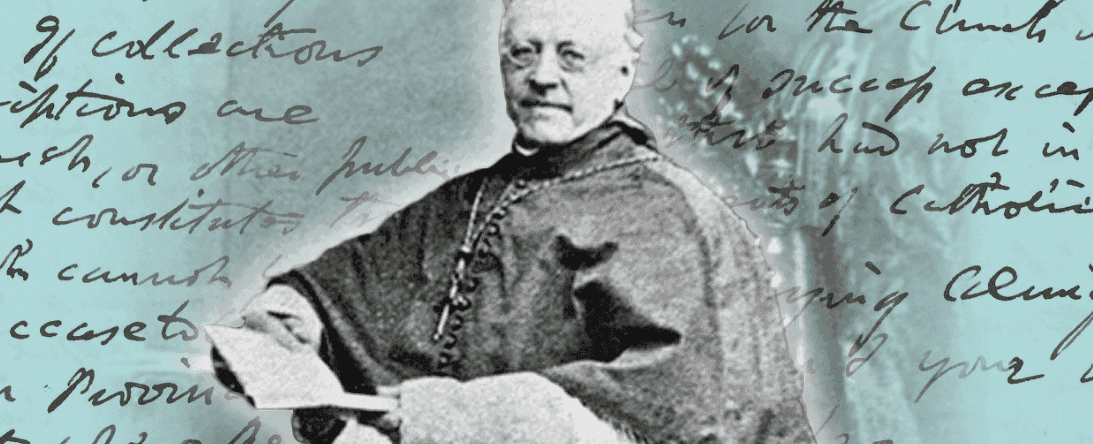Psycholinguistics and Paleography: Analyzing Letters from Ullathorne to Newman

Fluent readers can recognize familiar words by their overall shape as opposed to their individual letters,1 but when transcirbing historical documents, paleographers are often confronted with novel words and unfamiliar spellings. For example, if you read the introductory statement quickly, you may have missed the misspelling of the word transcribing since your brain followed the word shape instead of reading each individual letter. This is why alternate mental strategies are used by paleographers when reading and transcribing documents to accurately preserve the writer’s original words. Paleographers can refine their transcription processes and analysis of historical documents by utilizing some theories and findings from psycholinguistics. Psycholinguistics is a sub-field of psychology and is best defined as the study of mental processes involved in language production, comprehension, and storage.2
A challenging aspect of paleography is transcribing documents with variable scripts. William Ullathorne’s handwriting changes from his early letters, like this December 1849 letter, to his later letters, like this October 1864 letter, both of which were written to Newman. Handwriting can be affected by the writer’s health, emotional state, and their intended audience.3 Handwriting variability can limit a paleographer’s ability to determine an author’s intended letter, word, or phrase, but there are strategies to limit these effects and other limitations.

One of the first pieces of advice I received when starting paleography was to read a document in its entirety before attempting to transcribe it. Paleographers will complete a preliminary read through a document to ascertain its intended audience, textual themes, and historical allusions. My internship at the National Institute for Newman Studies focused on transcribing letters from Ullathorne (1806–1889) to Newman from the years 1848–1867. Over time, I became familiar with the relationship between Ullathorne and Newman through reading and transcribing these letters. Ullathorne was one of the first bishops to accept Newman as a religious leader following Newman’s conversion to Catholicism from Anglicanism. Their correspondence began due to their mutual interest in the creation of the Birmingham Oratory, and their friendship flourished over time as Newman rose in authority, eventually becoming a cardinal. Ullathorne and Newman wrote to each other regularly on various topics, such as the establishment of an Oratory in Oxford, church politics, and their personal affairs, until Ullathorne’s death in the late 1880s. My familiarity with the author and audience of the letters (Newman) provided essential context while I was transcribing.
Words themselves also provide context when reading a document. Readers identify letters faster when they are seen in the context of words according to the word superiority effect,4 so it is faster for paleographers to transcribe words as opposed to transcribing letter by letter. There is also evidence for a sentence superiority effect, which means words contained in a grammatically correct sentence are easier to recall.5 Paleographers can transcribe documents quickly by grouping strokes into words and sentences mentally as they transcribe. Although this is a fast method of transcribing, it is not the most accurate since many of the texts being transcribed include spelling errors and unfamiliar phrases. The word superiority effect is an example of top-down processing, a mode of information processing that uses high-level information, like a word, to process low-level information, like letters. Current research supports an interactive language processing model, which combines both top-down and bottom-up processing.6 Bottom-up processing is a method of information processing that uses low-level information, like letters, to ascertain high-level information, like a word. This is why paleographers may segment challenging words into letters to determine the author’s intended word. This technique is especially helpful when deciphering misspelled or uncommon words.

Another key piece of advice I received was to read each document aloud. Reading aloud has been shown to increase the detection of contextual and non-contextual errors when reading texts.7 Paleographers can read letters aloud when checking for non-contextual errors, like misspellings, and contextual errors, like incorrect word usage or grammatical errors. After repeated exposure, paleographers are familiarized with an author’s common misspellings and writing idiosyncrasies. For example, Ullathorne sometimes dropped the endings of words like “remain” in his signoff, and used a unique symbol for the double s in words like “mission.” Examples of this can be seen in Ullathorne’s June 1853 letter to Newman.
The best advice I was given to improve my transcriptions was to practice. Familiarity and experience with Ullathorne’s frequently used phrases and abbreviations like “I remain your devoted st in xt,” read as “I remain your devoted servant in Christ,” is instrumental in the transcription of these letters. Commonly used words are typically recognized faster and with greater accuracy compared to less-commonly used words when reading. Additionally, words that a reader was exposed to recently are given a recognition advantage over words not recently used.8 Ullathorne’s March 1861 letter frequently mentions Mr. Op Broek, Cardinal Barnabo, Mr. Massam, and other individuals. These names and other commonly used words like “and,” “the,” and “this” can be quickly transcribed due to the frequency and recency effects. There are countless articles that cover standard paleography techniques, but hands-on experience proved to be the best method of instruction.
There are currently 252 digital items in the NINS Digital Collections that are labelled as the Ullathorne to Newman letters. Some of these items are copies of letters, but the large quantity of digital letters provides a useful sample of Ullathorne’s writing style. These letters offer insight into the relationship between Newman and Ullathorne, church politics, and their personal affairs. They also serve as an accessible introduction to paleography and writings of the 1800s. If you are interested in paleography, I recommend you study these letters or consult similar works in the NINS Digital Collections.
1 Paul Warren, Introducing Psycholinguistics (Cambridge: Cambridge University Press, 2013), 109.
2 Warren, Introducing Psycholinguistics, 4.
3 Warren, Introducing Psycholinguistics, 102–103.
4 Warren, Introducing Psycholinguistics, 109–110.
5 Joshua Snell and Jonathan Grainger, “The sentence superiority effect revisited,” Cognition 168 (Nov. 2017): 217–21.
6 Warren, Introducing Psycholinguistics, 5.
7 Cassandra Cushing, and Glen Bodner E., “Reading Aloud Improves Proofreading (but Using Sans Forgetica Font Does Not),” Journal of Applied Research in Memory and Cognition 11, no. 3 (2022): 427–36.
8 Warren, Introducing Psycholinguistics, 132-33.
Share
Angela Baker
Angela Baker was an intern at the National Institute for Newman Studies (NINS) during the summer of 2024, and now serves as the Digital Humanities and Editorial Specialist at NINS.
Topics
Newsletter
QUICK LINKS

